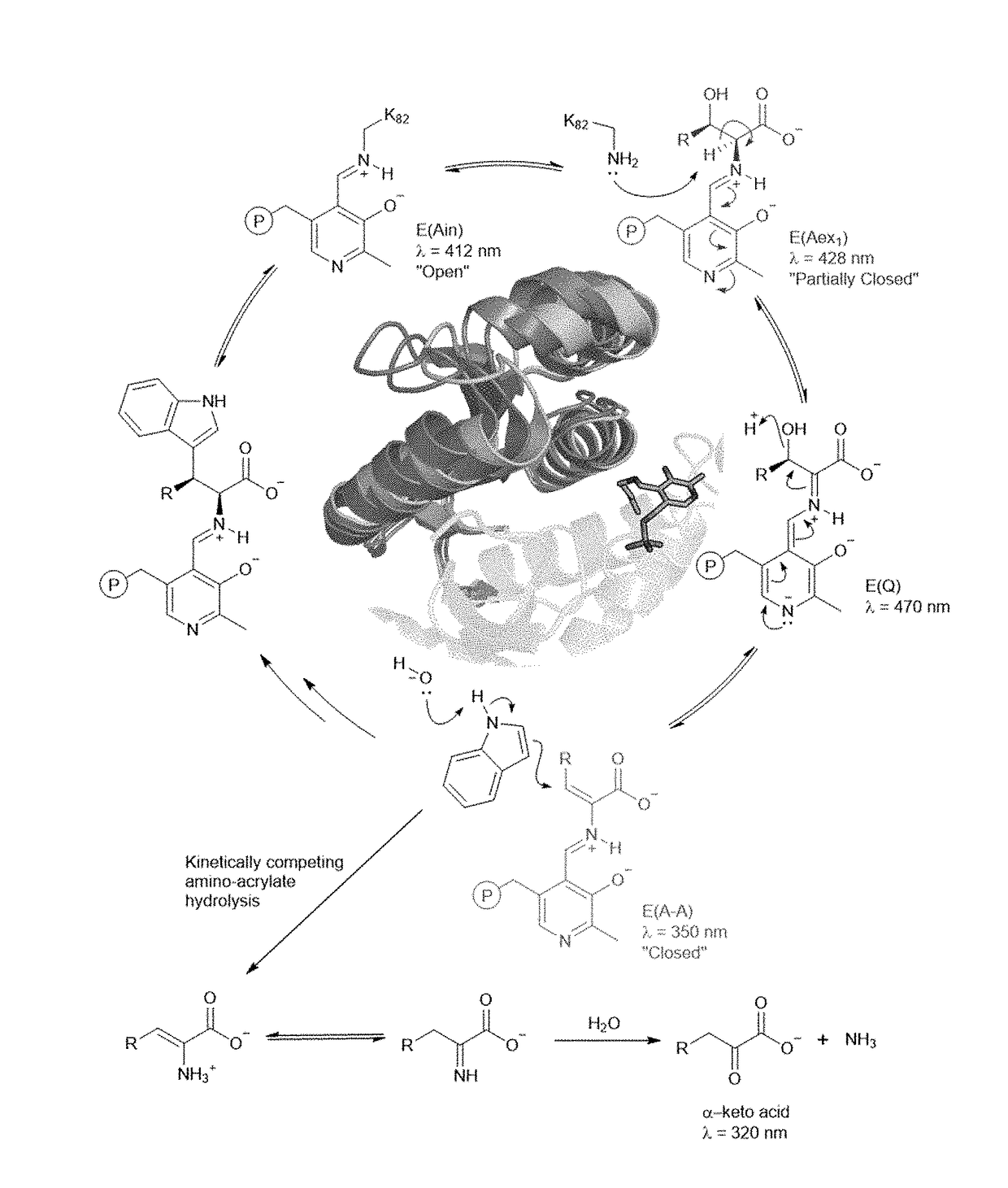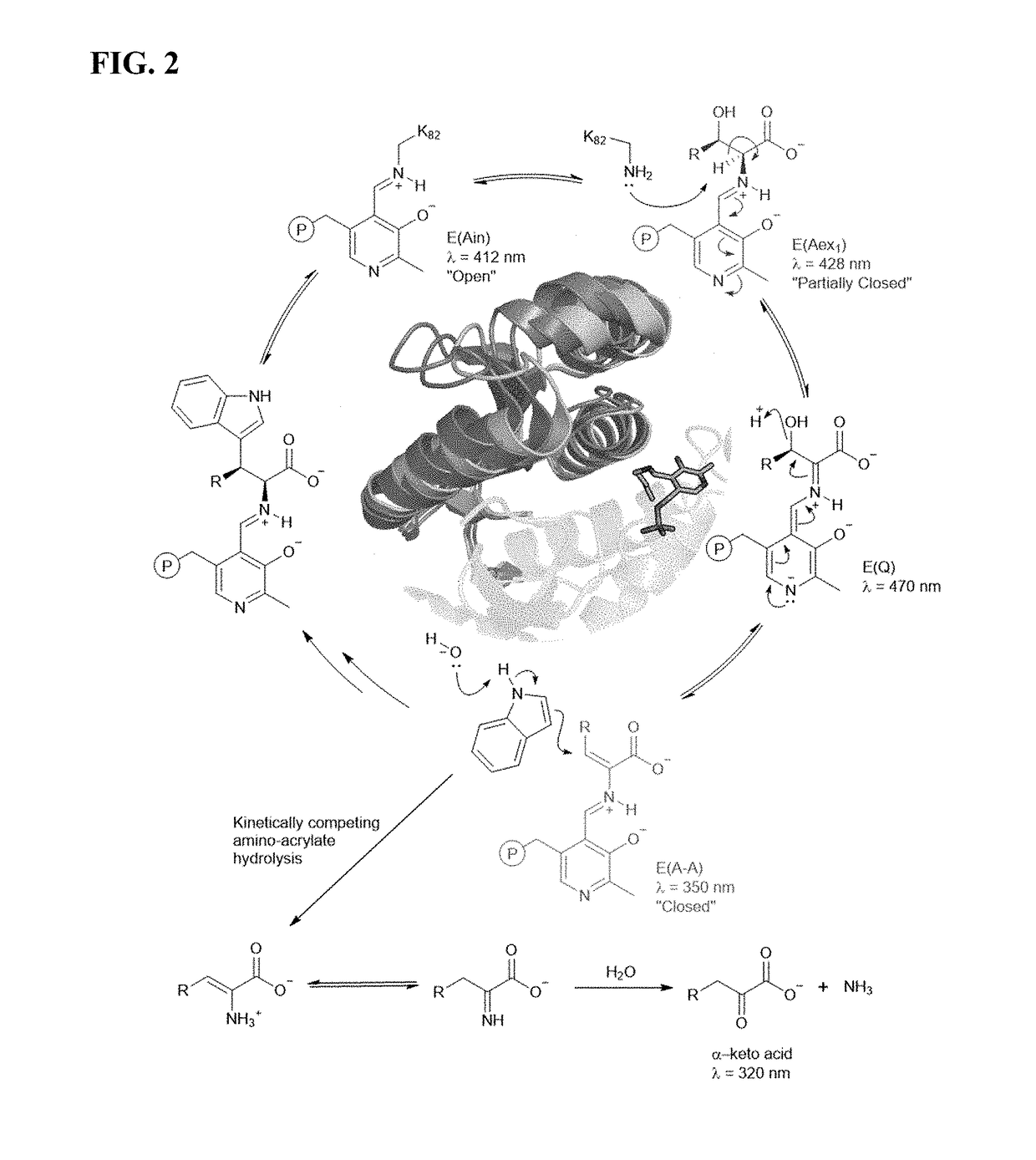Methods and enzyme catalysts for the synthesis of non-canonical amino acids
a technology of enzyme catalysts and amino acids, which is applied in the direction of lyases, carbon-oxygen lyases, peptide sources, etc., can solve the problems that the -branched ncaas are not readily available, and achieve the effect of preventing hydrolysis and/or deamination
- Summary
- Abstract
- Description
- Claims
- Application Information
AI Technical Summary
Benefits of technology
Problems solved by technology
Method used
Image
Examples
example 1
ation of Effective Trp-Forming Catalysts Via Enzyme Screening
[0174]Mechanistic analysis has shown that PfTrpB's yield and substrate scope are limited by competing hydrolysis of the reactive amino-acrylate intermediate (E(A-A)) (FIG. 2A), resulting in abortive deamination that consumes the amino acid substrate (FIG. 2A). Deamination can be overcome with additional equivalents of Thr, but the reaction scope and yields (typically 2B9 is effective only for the synthesis of β-methyltryptophan analogs, while synthesis of other β-branched ncAAs remained elusive. To surmount these challenges, it was envisioned that increasing the persistence of the reactive intermediate would decrease deamination while simultaneously facilitating reactions with more challenging β-alkylated substrates. It was further speculated that active-site mutations would enhance activity with larger β-substituents that are sterically disfavored. The ideal synthase would be able to utilize diverse indole and amino acid ...
example 2
neering Provides Enhanced Catalyst Activity
[0186]Cloning.
[0187]PfTrpBWT (UNIPROT ID Q8U093) was previously codon optimized for expression in Escherichia coli, and cloned into pET-22b(+) with a C-terminal 6×His tag. Parent variant PfTrpB2B9 (E17G, I68V, T292S, F274S, T321A, F95L, I16V, V384A) was cloned and expressed as described previously (see, Herger, et al. J. Am. Chem. Soc. 138, 8388-8391 (2016)).
[0188]Construction of Random Mutagenesis Libraries.
[0189]Random mutagenesis libraries were generated with the appropriate PfTrpB gene as template by the addition of 200-400 μM MnCl2 to a Taq PCR reaction as reported previously (see. Duller, et al. Proc. Natl. Acad. Sci. U.S.A. 112, 14599-14604 (2015)). PCR fragments were treated with DpnI for two hours at 37° C., purified by gel extraction, and then inserted into a pET-22b(+) vector via Gibson assembly (see, Gibson, et al. Nat. Methods 6, 343-345 (2009)). BL21(DE3) E. Cloni® Express cells were transformed with the Gibson assembly produc...
example 3
ic Study of TrpB Catalysts
[0205]Newly evolved properties of PfTrpB that enabled activity with challenging β-branched substrates were then identified.
[0206]Steady-State Distribution of Catalytic Intermediates.
[0207]Spectra were collected between 250 nm and 500 nm immediately following substrate addition. Samples were prepared in a total volume of 400 μL with 20 μM purified enzyme and 20 mM substrate (threonine, β-L-ethylserine, β-L-propylserine) in 50-200 mM KPi buffer, pH 8.0. Data were baseline subtracted and normalized to the E(Ain) peak at 412 nm. Catalytic intermediates were assigned at the following wavelengths: E(Ain) at 412 nm, E(Aex1) at 428 nm, and E(A-A) at 350 nm.
[0208]Deamination of the Amino-Acrylate.
[0209]Spectra were collected between 250-550 nm immediately following substrate addition, and then once per minute for ten minutes. Samples were prepared in a total volume of 400 μL with 20 μM purified enzyme and 20 mM substrate (Threonine, β-L-ethylserine, β-L-propylserine...
PUM
 Login to View More
Login to View More Abstract
Description
Claims
Application Information
 Login to View More
Login to View More - R&D
- Intellectual Property
- Life Sciences
- Materials
- Tech Scout
- Unparalleled Data Quality
- Higher Quality Content
- 60% Fewer Hallucinations
Browse by: Latest US Patents, China's latest patents, Technical Efficacy Thesaurus, Application Domain, Technology Topic, Popular Technical Reports.
© 2025 PatSnap. All rights reserved.Legal|Privacy policy|Modern Slavery Act Transparency Statement|Sitemap|About US| Contact US: help@patsnap.com



